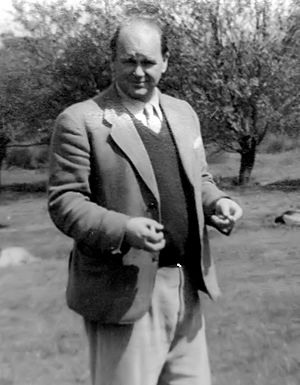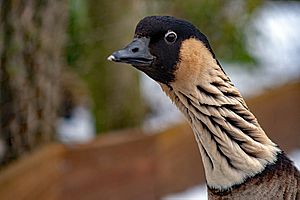WWT Slimbridge facts for kids
Quick facts for kids WWT Slimbridge |
|
|---|---|
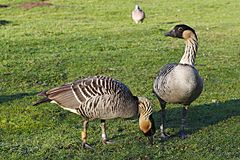
Slimbridge has numerous nene (also known as Hawaiian geese), the rarest goose in the world.
|
|
| Lua error in Module:Location_map at line 420: attempt to index field 'wikibase' (a nil value). | |
| OS grid | SO720048 |
| Area | 120 acres (49 ha) |
| Operated by | WWT |
| Status | Open |
WWT Slimbridge is a special wetland wildlife reserve in Gloucestershire, England. It is located near the village of Slimbridge, right by the River Severn estuary. This amazing place was started by an artist and naturalist named Sir Peter Scott. It first opened its doors in November 1946.
Peter Scott later created the Wildfowl & Wetlands Trust (WWT). This trust now runs nine wildlife reserves across the United Kingdom. Slimbridge itself covers about 800 hectares (2,000 acres) of land, including pastures, reed beds, lagoons, and salt marshes. Many different water birds live here all year. Other birds are migrants who stop here on their long journeys. Some birds, like white-fronted geese and Bewick's swans, spend the winter here.
Slimbridge is home to the world's largest group of captive wildfowl (ducks, geese, and swans). It also does important research and helps with international captive breeding programmes. For example, Peter Scott discovered that he could tell individual Bewick's swans apart by the unique patterns on their beaks. People can visit Slimbridge all year round. You can see the bird collections, watch wild birds from special hides, and join in fun educational activities.
Contents
History of Slimbridge Wetlands
The Wildfowl and Wetland Trust at Slimbridge was founded by Peter Scott. It opened on November 10, 1946. His goal was to create a place for research and conservation. It was quite unusual at the time, but he decided to open the site to the public. This way, everyone could enjoy and learn about nature.
This small beginning grew into the Wildfowl & Wetlands Trust (WWT). This is a charity in the United Kingdom that works to protect wetland birds and their homes. They work both in Britain and around the world. Even though WWT started at Slimbridge, it now manages eight other reserves in Britain. It also speaks up for wetlands and conservation issues globally.
A statue of Peter Scott, made by Jacqueline Shackleton in 1986, is on display at Slimbridge. His wife, Lady Scott, also has a bronze sculpture in the visitor centre. Peter Scott's mother, Kathleen Scott, also has a sculpture on display.
Exploring the Slimbridge Site
The Slimbridge reserve covers 800 hectares (2,000 acres) of land. Part of this area is designed for visitors to explore. Slimbridge has the biggest collection of wildfowl species in the world. Wild birds often mix with these captive birds in their enclosures. Some of the captive birds are part of international breeding programmes to help save rare species.
The reserve has different types of land. This includes pastureland that often floods in winter, lagoons, reed beds, and salt marshes. It is also next to the Severn Estuary. Many wildfowl visit the site. You might see greater white-fronted geese, Eurasian spoonbills, pied avocets, and even common cranes. Some of the cranes were raised here and then released into the wild.
Slimbridge is also home to some rare plants. These include the grass-poly and a special type of bee orchid called the wasp orchid.
Birds You Can Spot
The number of ducks, geese, and swans is highest in winter. You can see large groups of greater white-fronted geese. Sometimes, a rare lesser white-fronted goose might be among them. Bewick's swans are a big attraction in winter. They fly all the way from northern Russia to enjoy the milder weather in southern England. Scientists at Slimbridge have studied their behaviour closely.
Birds of prey like peregrines and merlins also visit in winter. You might also see wading birds and some woodland birds. It's a great place to try and spot the shy water rail.
Some birds live at Slimbridge all year round. These include little and great crested grebes, lapwing, redshank, tufted duck, gadwall, kingfisher, reed bunting, great spotted woodpecker, sparrowhawk, and little owl.
In spring, wading birds stop at the pools by the estuary. These include Eurasian whimbrel, common, wood, and green sandpipers. Other spring visitors are spotted redshank, common greenshank, avocet, little gull, and black tern. Migrant birds like northern wheatear, whinchat, common redstart, and black redstart also arrive.
Swans and geese usually start arriving in late October. In autumn, you can see wading birds like red knot, black-tailed godwit, dunlin, ringed and grey plovers, ruff, common greenshank, spotted redshank, curlew sandpiper, and common, wood, and green sandpipers.
Besides Bewick's swans and white-fronted geese, other large waterfowl seen in winter include the brent goose, pink-footed goose, barnacle goose, and taiga bean goose. The swans often fly off during the day to feed and return in the late afternoon. Another amazing sight in winter evenings is the arrival of huge groups of starlings. Smaller wildfowl in winter include wigeon, Eurasian teal, common pochard, northern pintail, water rail, dunlin, redshank, curlew, golden plover, common snipe, and ruff.
Conservation Projects at Slimbridge
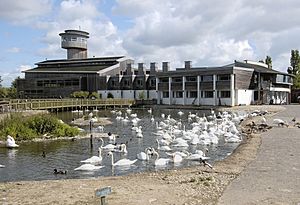
Before WWT Slimbridge was created, Bewick's swans did not regularly spend their winters on the Severn Estuary. In 1948, one swan arrived at Slimbridge. It might have been attracted by a captive whistling swan. A mate for this swan was brought from the Netherlands, and they successfully had cygnets (baby swans). More wild Bewick's swans joined the group. By 1964, over thirty wild swans were present.
To study the birds better, the tame resident swans were moved to a lake where they could be easily watched. Peter Scott noticed that each swan had a unique pattern of black and yellow on its beak. This allowed him to recognise individual birds. He drew these patterns like "mug shots" to help identify them. By 1989, over six thousand swans had visited the site. This method allowed for a lot of important research on these birds.
One big success story in the 1950s was saving the nene (or Hawaiian goose) from extinction. Birds were brought to Slimbridge, and they bred successfully. Early attempts to release them back into the wild in Hawaii didn't work well. This was because the nene's natural home was not safe from new predators that humans had brought to the islands. Once this problem was fixed, the reintroduction became successful.
In 1951, during Princess Elizabeth's visit to Canada, she was promised a gift of trumpeter swans. Peter Scott helped arrange this. Canadian officials found that the only swans tame enough to catch were at Lonesome Lake in British Columbia. This was because a conservationist named Ralph Edwards had been feeding them for decades. In 1952, with help from Ralph and his daughter Trudy, five swans were caught. They were then flown to England. This was the first time trumpeter swans had ever flown across the Atlantic. Sadly, one swan died, but the other four lived happily at WWT Slimbridge for many years.
Slimbridge has also worked to increase the number of common cranes. These birds had only bred in Britain now and then since the late 1970s. A special "Crane School" was built where young cranes learn how to find food and stay safe. This project has led to many cranes being released into the wild. For example, 23 birds were released in September 2013, and 93 by the end of 2015.
In September 2016, a researcher from Slimbridge became a "human swan." She followed migrating Bewick's swans using a powered paraglider. She wanted to find out what dangers they face during their migration. She also wanted to understand why their numbers had dropped by half in twenty years. Her 4,500 mi (7,200 km) journey from the Arctic tundra of Russia to Slimbridge took about ten weeks.
Visitor Facilities at Slimbridge
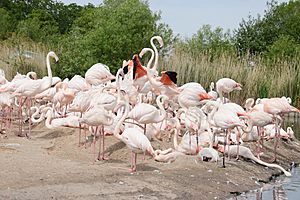
The Sloane Observation Tower at Slimbridge offers amazing views. You can see the Cotswold escarpment to the east. To the west, you can see the River Severn and the Forest of Dean. The visitor centre has a shop, a restaurant by the water, a cinema, an art gallery, and a tropical house. There are also exhibitions in the "Hanson Discovery Centre."
Visitors can use sixteen different hides for bird watching. There are also several comfortable observatories. Slimbridge offers educational visits for schools. They also have guided walks, special events, talks, and workshops for everyone.
You are allowed to feed the captive birds with special food mixes bought on site. In winter, you can watch wild birds being fed near one of the hides at certain times. Sometimes, these feeding sessions happen in the evening with floodlights for groups.


